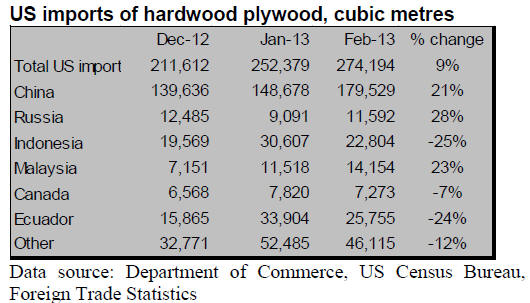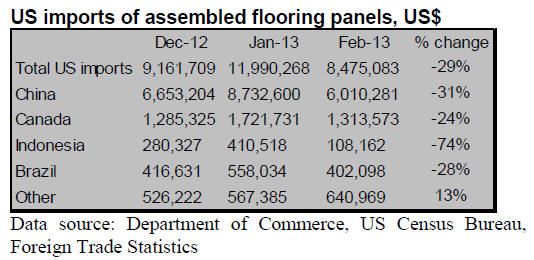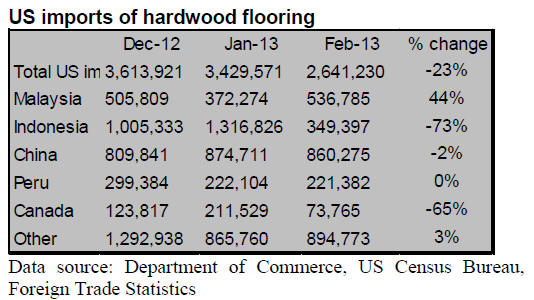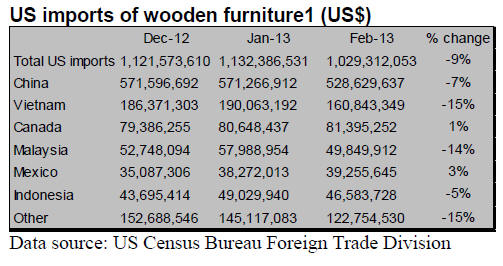|
Report
from
North America
Sight improvement in US employment
Employment improved slightly in March. The unemployment rate was 7.6% in
March, down from 7.7% in February, according to the US Bureau of Labor
Statistics.
The number of jobs in construction increased, as the housing market
recovers and demand for new homes and remodelling grows.
Higher home prices support consumer confidence
Rising home prices, stock prices and improving employment contributed to
higher consumer confidence in March.
The Thomson Reuters/University of Michigan consumer sentiment index rose
from 77.6 in February to 78.6 in March.
Personal income levels are unlikely to increase this year. But higher
home prices increase household wealth and support spending. Consumers
appear less worried about an economic downturn despite the cuts in
federal spending.
Decline in home buildersí» confidence despite housing market recovery
Home builder confidence fell by two points to 44 in March, despite
higher demand for houses. Only when the Housing Market Index by the
National Association of Home Builders/Wells Fargo climbs over 50, the
majority of home builders regard market conditions as good.
The association attributes the decline in confidence in the market for
single-family homes to the following factors:
• Difficult access to credit
• Rising prices and shortage of building materials
• Shortage of skilled labour in construction
February home sales down
Home sales slowed in February following the strong sales activity in
January. Sales of new homes declined by 4.6% in February this year
however, the inventory of new, unsold homes remains below normal levels.
US housing starts increased slightly from the previous month.
Construction started on 917,000 homes in February (seasonally adjusted
annual rate), up by 0.8% from the previous month.
The number of starts were almost a third higher than in February 2012.
Single-family starts grew by 0.5% from January. The share of
single-family homes in total starts remained stable at 67%.
The number of building permits issued for new single-family homes was
946,000 in February (seasonally adjusted annual rate), up 4.6% from
January. The number of permits issued is usually an indicator of future
building activity.
Canadian housing starts increase again
Canadaí»s housing starts increased by 14% in February, following a
decline in January. Home sales slowed, but resale market prices remain
relatively stable.
High home prices contribute to Canadaí»s very large household debt, which
reached over 150% of disposable income in 2012, compared to about 140%
in the US.
Non-residential construction expected to grow in 2013
Spending on non-residential building construction was unchanged in
February. Compared to the same time last year, private non-residential
construction is 6% higher, while public construction is lower due to
lower public spending.
Non-residential construction spending is expected to grow in the second
half of 2013, according to the Architecture Billings Index. In February
the index registered its strongest growth since early 2008. Architecture
firms reported growth in all major building sectors.
Two thirds of the firms surveyed also reported that building codes and
regulations have become more stringent. Energy codes and regulations for
building accessibility have changed the most, which can increase design
and construction cost.
US imports of processed wood products slowed in February
The growth in wood product imports slowed from the previous month, but
imports remain significantly higher than at the same time last year.
Hardwood plywood
US imports of hardwood plywood continued increasing in February. Total
imports were 274,194 m³, up 9% from January and 50% higher than
year-to-date 2012. The growth was mainly due to higher imports from
China, which rose to 179,529 m³ (+49% year-to-date).

Imports from Indonesia (22,804 m³) and Ecuador (25,755 m³) declined from
January, but on a year-to-date basis Ecuador is still the second largest
supply source after China. Imports from Malaysia were 14,154 m³ in
February (+45% year-to-date).
Hardwood moulding
Hardwood moulding imports declined to $12.5 million (-5% year-to-date).
Imports from China were worth $4.8 million (-7% year-to-date). Imports
from all other major suppliers also declined. Hardwood moulding imports
from Brazil were $2.8 million, down 15% from year-to-date 2012.

Wood flooring
US imports of assembled flooring panels declined to $8.5 million in
February, but they remain 27% above year-to-date imports in February
2012.

Imports from China were $6.0 million (+30% year-to-date). Year-to-date
imports from Canada and Indonesia grew more moderately, while Brazilí»s
shipments surpassed Indonesia at $0.4 million (+80% year-to-date).
Hardwood flooring imports declined further to $2.6 million in February
(+54% year-to-date). China is the largest supply source ($0.9 million in
February, +87% year-to-date).

Indonesia has been the second-largest supplier in 2013, although
February shipments declined to less than $0.4 million. Malaysian
hardwood flooring exports increased to $0.5 million in February (-30%
year-to-date).
Wooden furniture
US imports of wooden furniture declined in February after trending
higher in December and January. February imports were worth $1.029
billion, 9% down from the previous month.
Much of the decline is in furniture imports from China, Vietnam and
Malaysia, while imports from Canada and Mexico increased. Year-to-date
February imports of wooden furniture are 12% higher than in 2012.

1 Excluding furniture parts
Includes:
940161 Seats W Wooden Frames, Upholstered, Nesoi
940169 Seats W Woodn Frames, Not Upholstered, Nesoi
940330 Wooden Office Furniture, Except Seats
940340 Wooden Kitchen Furniture, Except Seats
940350 Wooden Bedroom Furniture, Except Seats
940360 Wooden Furniture, Nesoi
Chinaí»s furniture exports to the US decreased to $528.6 million in
January (+17% year-to-date). Vietnamí»s shipments were $160.8 million
(+13% year-to-date), while imports from Malaysia declined to $49.8
million (-1% year-to-date).
US producers raise wood flooring prices
The National Wood Flooring Association reported on April 1 that large US
manufacturers of engineered and solid wood floors will raise prices by
up to 10%. This would be the second or third price increase for many
producers since November 2012. According to the manufacturers, price
increases are necessary because of the rising cost of raw materials.
Remodelling market outlook
The remodelling, renovation and repair of homes, is a significant
market for processed wood products. The majority of kitchen and bath
cabinets are sold for remodelling, and in recent years over half of the
wood flooring sold was used for remodelling, according to the National
Wood Flooring Association.
Demand for a range of other wood products, such as furniture, mouldings,
stairs and doors, is also linked to the remodeling of homes.
The Joint Center of Housing Studies of Harvard University expects growth
in remodelling spending to accelerate in 2013. The Hardwood Review
Weekly has analysed how the economy and the housing market will affect
the remodelling sector:
Homeowners are more likely to remodel when home prices are rising, as is
the case now.
A large number of foreclosed homes are still likely to come on the
market. A large share (one third) of foreclosed homes was bought by
investors in 2012. Investors tend to spend more on the remodeling of
foreclosed homes than banks or homeowners.
Existing homes need more improvements since homeowners spent less money
on remodeling during the recession and fewer new homes were built.
Low interest rates encourage more homeowners to take out a loan for
remodeling projects.
The following obstacles for the remodeling market were identified:
The inventory of existing and new homes is below average. This limits
sales and therefore remodeling by sellers and buyers of houses.
Access to credit is still tight, which also limits home sales.
Remodeling depends on consumer confidence. If unemployment grows and
economic growth slows, spending on remodeling can quickly decline.
Employment in the construction sector grew in March, but many home
builders and contractors still report a lack of skilled workers to carry
out remodeling projects.
* The market information above has been generously provided by the
Chinese Forest Products Index Mechanism (FPI)
|